Spring Runoff Simulation of Snow-Dominant Catchment in Steppe Regions: A Comparison Study of Lumped Conceptual Models
Abstract
:1. Introduction
- A typical experience is a short and intense flood that begins in the third pentad of March and ends in the first-third pentad of April;
- Rain floods are either absent or weakly expressed.
2. Methodology
2.1. CemaNeige Snow Model
2.2. HBV Snow Model
3. Study Area
4. Results and Discussion
4.1. Atmospheric Circulation Influence
- Snow accumulation primarily occurs when moisture-laden air masses from the North Atlantic move into the region, corresponding to ECM types 1 and 2;
- The most significant soil freezing takes place during the influx of Arctic air masses and the development of anticyclones;
- The highest levels of preceding autumn moisture, which influence soil moisture content and the formation of runoff losses due to infiltration during the snowmelt period, are associated with zonal circulation patterns (types 1–7)—in contrast, the lowest levels occur during the movement of air masses from Central Asia as well as from the Arctic (types 8–13).
- In order to establish a correlation between circulation patterns and autumn precipitation, this study analyzed the frequency of each circulation group during September–October.
- To investigate the relationship between snow reserve amounts and different circulation patterns, the frequency of each circulation group for November–December and January–March is analyzed.
4.2. Strategy for Conceptual Model Setup
4.3. Discussion
5. Conclusions
Author Contributions
Funding
Institutional Review Board Statement
Data Availability Statement
Conflicts of Interest
References
- Dalla Torre, D.; Di Marco, N.; Menapace, A.; Avesani, D.; Righetti, M.; Majone, B. Suitability of ERA5-Land reanalysis dataset for hydrological modelling in the Alpine region. J. Hydrol. Reg. Stud. 2024, 52, 101718. [Google Scholar] [CrossRef]
- Vasil’ev, D.; Vodopyanov, V.; Zayzeva, G.; Zakirzyanov, S.; Semenov, V.; Sivokhip, Z.; Chibilev, A. Long-term forecast model of spring runoff on the Belaya river. Dokl. Earth Sci. 2019, 486, 723–726. [Google Scholar] [CrossRef]
- Valery, A.; Andreassian, V.; Perrin, C. As simple as possible but not simpler: What is useful in a temperature-based snow-accounting routine? Part 2 – Sensitivity analysis of the Cemaneige snow accounting routine on 380 catchments. J. Hydrol. 2014, 517, 1176–1187. [Google Scholar] [CrossRef]
- Zaramella, M.; Borga, M.; Zoccatelli, D.; Carturan, L. TOPMELT 1.0: A topography-based distribution function approach to snowmelt simulation for hydrological modelling at basin scale. Geosci. Model Dev. 2019, 12, 5251–5265. [Google Scholar] [CrossRef]
- Di Marco, N.; Avesani, D.; Righetti, M.; Zaramella, M.; Majone, B.; Borga, M. Reducing hydrological modelling uncertainty by using MODIS snow cover data and a topography-based distribution function snowmelt model. J. Hydrol. 2021, 599, 126020. [Google Scholar] [CrossRef]
- Magnusson, J.; Nævdal, G.; Matt, F.; Burkhart, J.F.; Winstral, A. Improving hydropower inflow forecasts by assimilating snow data. Hydrol. Res. 2020, 51, 226–237. [Google Scholar] [CrossRef]
- Khalyasmaa, A.; Eroshenko, S.; Mazunina, M. Prospects for the Use of Intelligent Multi-agent Models for the Control of Objects of Deeply Integrated Power Systems. In Proceedings of the 2022 IEEE International Multi-Conference on Engineering, Computer and Information Sciences (SIBIRCON), Yekaterinburg, Russia, 11–13 November 2022; pp. 730–733. [Google Scholar] [CrossRef]
- Eroshenko, S.; Matrenin, P.; Khalyasmaa, A.; Klimenko, D.; Sidorova, A. Data Processing Technology for the Forecasting of the Water Inflow into a Reservoir with the Use of Earth Remote Sensing and the Network of Meteorological and Hydrological Posts. Probl. Reg. Energetics 2022, 56, 100–109. [Google Scholar] [CrossRef]
- Hawker, L.; Bates, P.; Neal, J.; Rougier, J. Perspectives on Digital Elevation Model (DEM) Simulation for Flood Modeling in the Absence of a High-Accuracy Open Access Global DEM. Front. Earth Sci. 2018, 6, 233. [Google Scholar] [CrossRef]
- Woldegebrael, S.M.; Kidanewold, B.B.; Melesse, A.M. Seasonal Flow Forecasting Using Satellite-Driven Precipitation Data for Awash and Omo-Gibe Basins, Ethiopia. Remote Sens. 2022, 14, 4518. [Google Scholar] [CrossRef]
- Matrenin, P.; Safaraliev, M.; Kiryanova, N.; Sultonov, S. Monthly Runoff Forecasting by Non-Generalizing Machine Learning Model and Feature Space Transformation (Vakhsh River Case Study). Probl. Reg. Energetics 2022, 55, 99–110. [Google Scholar] [CrossRef]
- Klimenko, D. Estimating the Probable Maximum Precipitation by Physical Methods Using Satellite and Radiolocation Observation Data: Case Study of the Middle Urals. Water Resour. 2020, 47, 443–452. [Google Scholar] [CrossRef]
- Susilowati, Y.; Irasari, P.; Kumoro, Y.; Hendriawan Nur, W.; Yunarto, Y. Micro hydropower plant potential study based on Landsat 8 operational land imager satellite data. Bull. Electr. Eng. Inform. 2021, 10, 3167–3177. [Google Scholar] [CrossRef]
- Udnæs, H.C.; Alfnes, E.; Andreassen, L.M. Improving runoff modeling using satellite-derived snow cover area. Water Policy 2007, 38, 21–32. [Google Scholar] [CrossRef]
- Kochendorfer, J.; Earle, M.; Rasmussen, R.; Smith, C.; Yang, D.; Morin, S.; Mekis, E.; Buisan, S.; Roulet, Y.A.; Landolt, S.; et al. How Well are We Measuring Snow Post-SPICE? Bull. Am. Meteorol. Soc. 2021, 103, E370–E388. [Google Scholar] [CrossRef]
- Watson, A.; Midgley, G.; Ray, P.; Kralisch, S.; Helmschrot, J. How Climate Extremes Influence Conceptual Rainfall-Runoff Model Performance and Uncertainty. Front. Clim. 2022, 4, 859303. [Google Scholar] [CrossRef]
- Stephens, C.; Marshall, L.; Johnson, F. Investigating strategies to improve hydrologic model performance in a changing climate. J. Hydrol. 2019, 579, 124219. [Google Scholar] [CrossRef]
- Astagneau, P.C.; Thirel, G.; Delaigue, O.; Guillaume, J.H.A.; Parajka, J.; Brauer, C.C.; Viglione, A.; Buytaert, W.; Beven, K.J. Technical note: Hydrology modelling R packages—A unified analysis of models and practicalities from a user perspective. Hydrol. Earth Syst. Sci. 2021, 25, 3937–3973. [Google Scholar] [CrossRef]
- Devia, G.; Bigganahalli Puttaswamigowda, G.; Dwarakish, G. A Review on Hydrological Models. Aquat. Procedia 2015, 4, 1001–1007. [Google Scholar] [CrossRef]
- Yaduvanshi, A.; Srivastava, P.; Worqlul, A.W.; Sinha, A.K. Uncertainty in a Lumped and a Semi-Distributed Model for Discharge Prediction in Ghatshila Catchment. Water 2018, 10, 381. [Google Scholar] [CrossRef]
- Gao, C.; He, Z.; Pan, S.; Weidong, X.; Xu, Y. Effects of climate change on peak runoff and flood levels in Qu River Basin, East China. J. -Hydro-Environ. Res. 2018, 28, 34–47. [Google Scholar] [CrossRef]
- Neri, M.; Parajka, J.; Toth, E. Importance of the informative content in the study area when regionalising rainfall-runoff model parameters: The role of nested catchments and gauging station density. Hydrol. Earth Syst. Sci. 2020, 24, 5149–5171. [Google Scholar] [CrossRef]
- Bergstrom, S. Development and Application of a Conceptual Runoff Model for Scandinavian Catchments; SMHI Rapporter: Norrkoping, Sweden, 1976; Volume 134. [Google Scholar]
- Lindstrom, G.; Johansson, B.; Persson, M.; Gardelin, M.; Bergstrom, S. Development and test of the distributed HBV-96 hydrological model. J. Hydrol. 1997, 201, 272–288. [Google Scholar] [CrossRef]
- Pianosi, F.; Wagener, T. A simple and efficient method for global sensitivity analysis based on cumulative distribution functions. Environ. Model. Softw. 2015, 67, 1–11. [Google Scholar] [CrossRef]
- Pianosi, F.; Beven, K.; Freer, J.; Hall, J.; Rougier, J.; Stephenson, D.; Wagener, T. Sensitivity analysis of environmental models: A systematic review with practical workflow. Environ. Model. Softw. 2016, 79, 214–232. [Google Scholar] [CrossRef]
- Moriasi, D.; Arnold, J.; Van Liew, M.; Bingner, R.; Harmel, R.; Veith, T. Model Evaluation Guidelines for Systematic Quantification of Accuracy in Watershed Simulations. Trans. ASABE 2007, 50, 885–900. [Google Scholar] [CrossRef]
- Ochoa-Tocachi, B.; Cuadros Adriazola, J.E.; Arapa, E.; Aste, N.; Ochoa-Tocachi, E.; Bonnesoeur, V. Guide to Hydrologic Modeling of Natural Infrastructure; Forest Trends: Lima, Peru, 2022. [Google Scholar] [CrossRef]
- Nash, J.; Sutcliffe, J. River flow forecasting through conceptual models part I — A discussion of principles. J. Hydrol. 1970, 10, 282–290. [Google Scholar] [CrossRef]
- Gupta, H.V.; Kling, H.; Yilmaz, K.K.; Martinez, G.F. Decomposition of the mean squared error and NSE performance criteria: Implications for improving hydrological modelling. J. Hydrol. 2009, 377, 80–91. [Google Scholar] [CrossRef]
- Majone, B.; Avesani, D.; Zulian, P.; Fiori, A.; Bellin, A. Analysis of high streamflow extremes in climate change studies: How do we calibrate hydrological models? Hydrol. Earth Syst. Sci. 2022, 26, 3863–3883. [Google Scholar] [CrossRef]
- Boughton, W. Effect of data length on rainfall-runoff modeling. Environ. Model. Softw. 2007, 22, 406–413. [Google Scholar] [CrossRef]
- Champagne, O.; Arain, M.; Coulibaly, P. Atmospheric circulation amplifies shift of winter streamflow in Southern Ontario. J. Hydrol. 2019, 578, 124051. [Google Scholar] [CrossRef]
- Yan, X.; Chang, Y.; Yang, Y.; Liu, X. Monthly runoff prediction using modified CEEMD-based weighted integrated model. J. Water Clim. Chang. 2020, 12, 1744–1760. [Google Scholar] [CrossRef]
- Wang, W.; Tang, S.; Zou, J.; Li, D.; Ge, X.; Huang, J.; Yin, X. Runoff Prediction in Different Forecast Periods via a Hybrid Machine Learning Model for Ganjiang River Basin, China. Water 2024, 16, 1589. [Google Scholar] [CrossRef]
- Malygina, N.; Papina, T.; Kononova, N.; Barlyaeva, T. Influence of atmospheric circulation on precipitation in Altai Mountains. J. Mt. Sci. 2017, 14, 46–59. [Google Scholar] [CrossRef]
- Lebedeva, M.G.; Lupo, A.R.; Chendev, Y.G.; Krymskaya, O.V.; Solovyev, A.B. Changes in the Atmospheric Circulation Conditions and Regional Climatic Characteristics in Two Remote Regions Since the Mid-20th Century. Atmosphere 2019, 10, 11. [Google Scholar] [CrossRef]
- Gorbunov, R.; Gorbunova, T.; Kononova, N.; Priymak, A.; Salnikov, A.; Drygval, A.; Lebedev, Y. Spatiotemporal aspects of interannual changes precipitation in the crimea. J. Arid. Environ. 2020, 183, 104280. [Google Scholar] [CrossRef]
- Bárdossy, A.; Anwar, F. Why do our rainfall–runoff models keep underestimating the peak flows? Hydrol. Earth Syst. Sci. 2023, 27, 1987–2000. [Google Scholar] [CrossRef]
- Liu, Y.; Gupta, H.V. Uncertainty in hydrologic modeling: Toward an integrated data assimilation framework. Water Resour. Res. 2007, 43. [Google Scholar] [CrossRef]
- Vrugt, J.A.; Robinson, B.A. Treatment of uncertainty using ensemble methods: Comparison of sequential data assimilation and Bayesian model averaging. Water Resour. Res. 2007, 43. [Google Scholar] [CrossRef]
- Piazzi, G.; Thirel, G.; Perrin, C.; Delaigue, O. Sequential Data Assimilation for Streamflow Forecasting: Assessing the Sensitivity to Uncertainties and Updated Variables of a Conceptual Hydrological Model at Basin Scale. Water Resour. Res. 2021, 57. [Google Scholar] [CrossRef]
- Lu, M.; Lu, S.; Liao, W.; Lei, X.; Yin, Z.; Wang, H. Research and application of parameter estimation method in hydrological model based on dual ensemble Kalman filter. Hydrol. Res. 2021, 53, 65–84. [Google Scholar] [CrossRef]
- Zheng, H.; Chiew, F.H.; Zhang, L. Can Model Parameterization Accounting for Hydrological Nonstationarity Improve Robustness in Future Runoff Projection? J. Hydrometeorol. 2022, 23, 1831–1844. [Google Scholar] [CrossRef]
- Kong-A-Siou, L.; Fleury, P.; Johannet, A.; Borrell Estupina, V.; Pistre, S.; Dörfliger, N. Performance and complementarity of two systemic models (reservoir and neural networks) used to simulate spring discharge and piezometry for a karst aquifer. J. Hydrol. 2014, 519, 3178–3192. [Google Scholar] [CrossRef]
- Bouhafa, N.; Sakarovitch, C.; Lalague, L.; Goulard, F.; Pryet, A. Hybrid modeling of karstic springs: Error correction of conceptual reservoir models with machine learning. Water Supply 2024, 24, 1559–1573. [Google Scholar] [CrossRef]

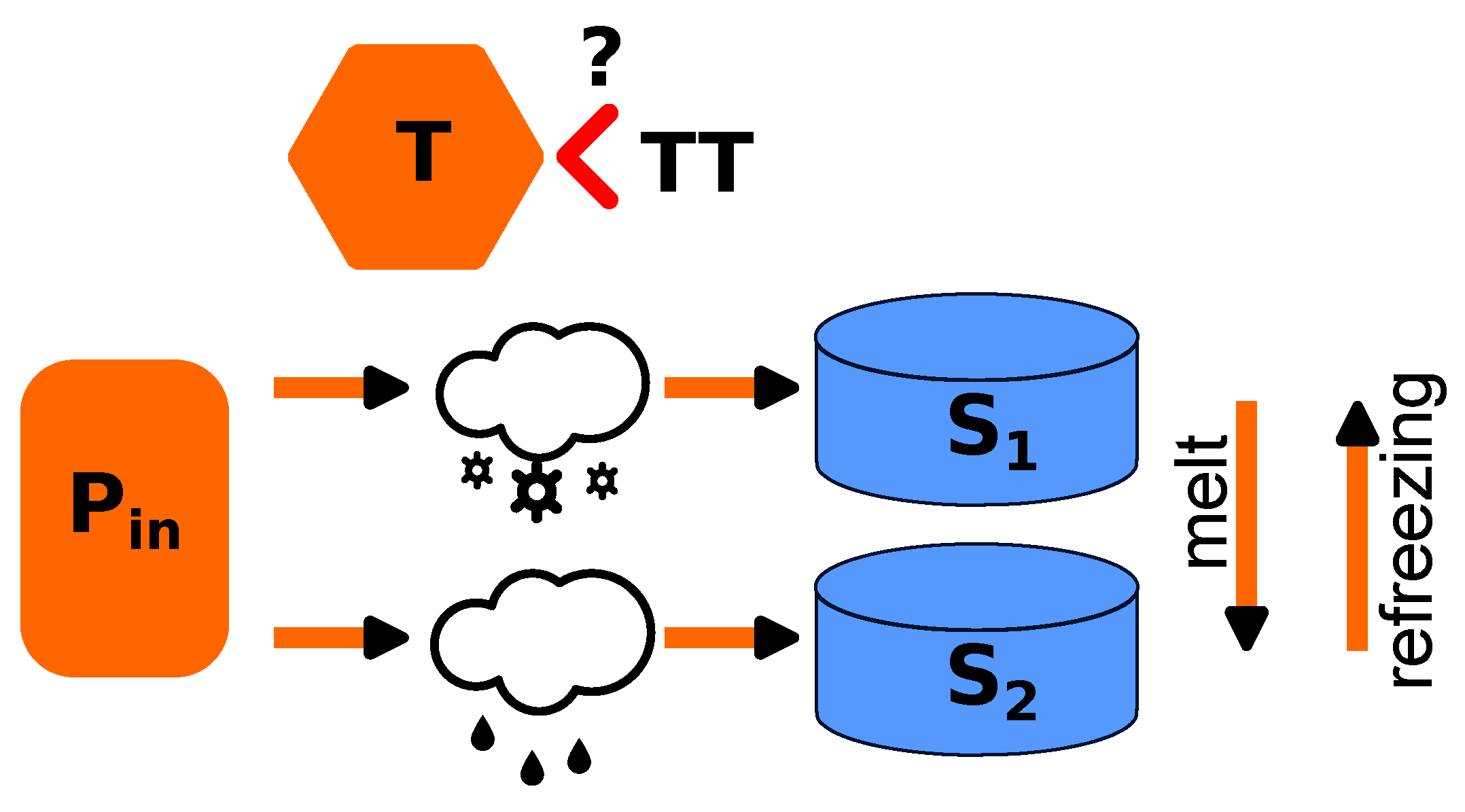
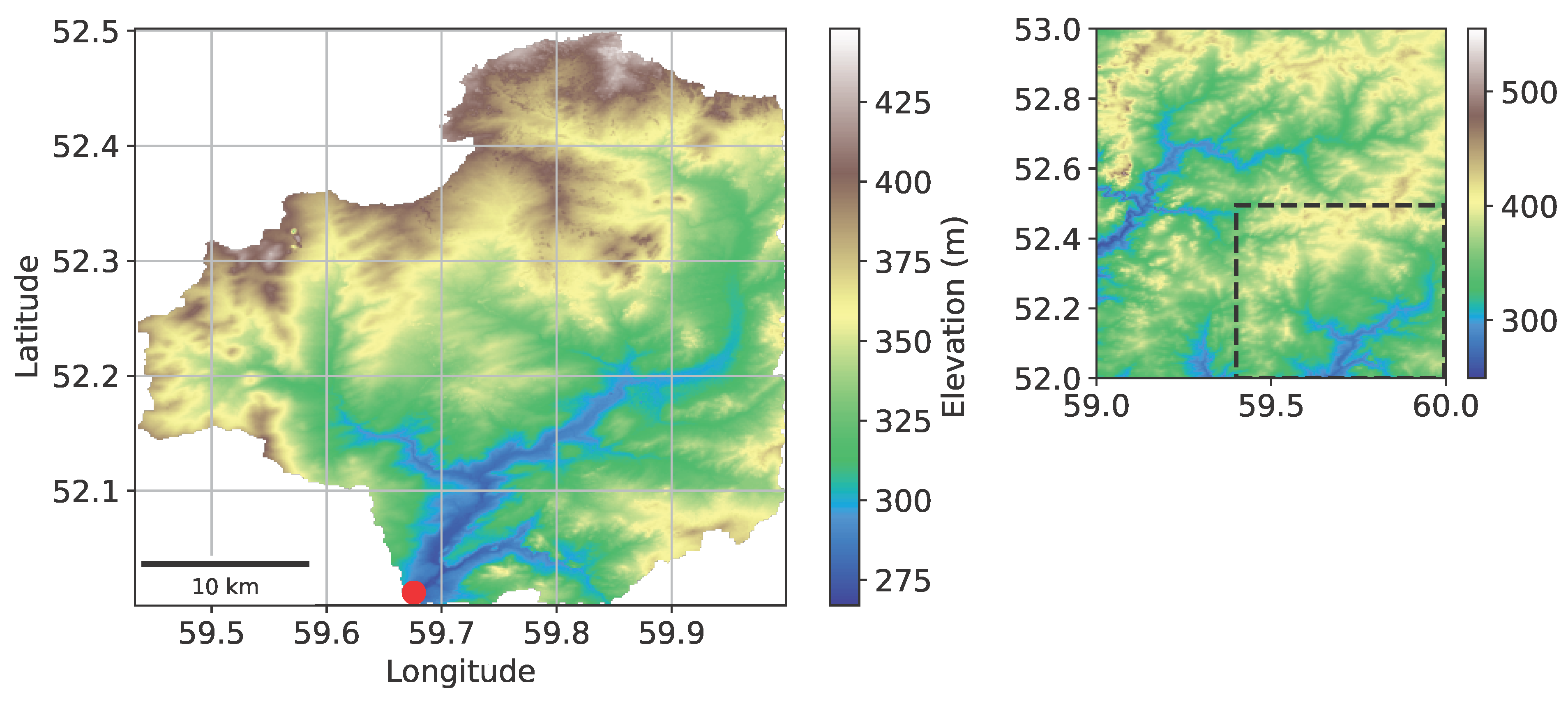
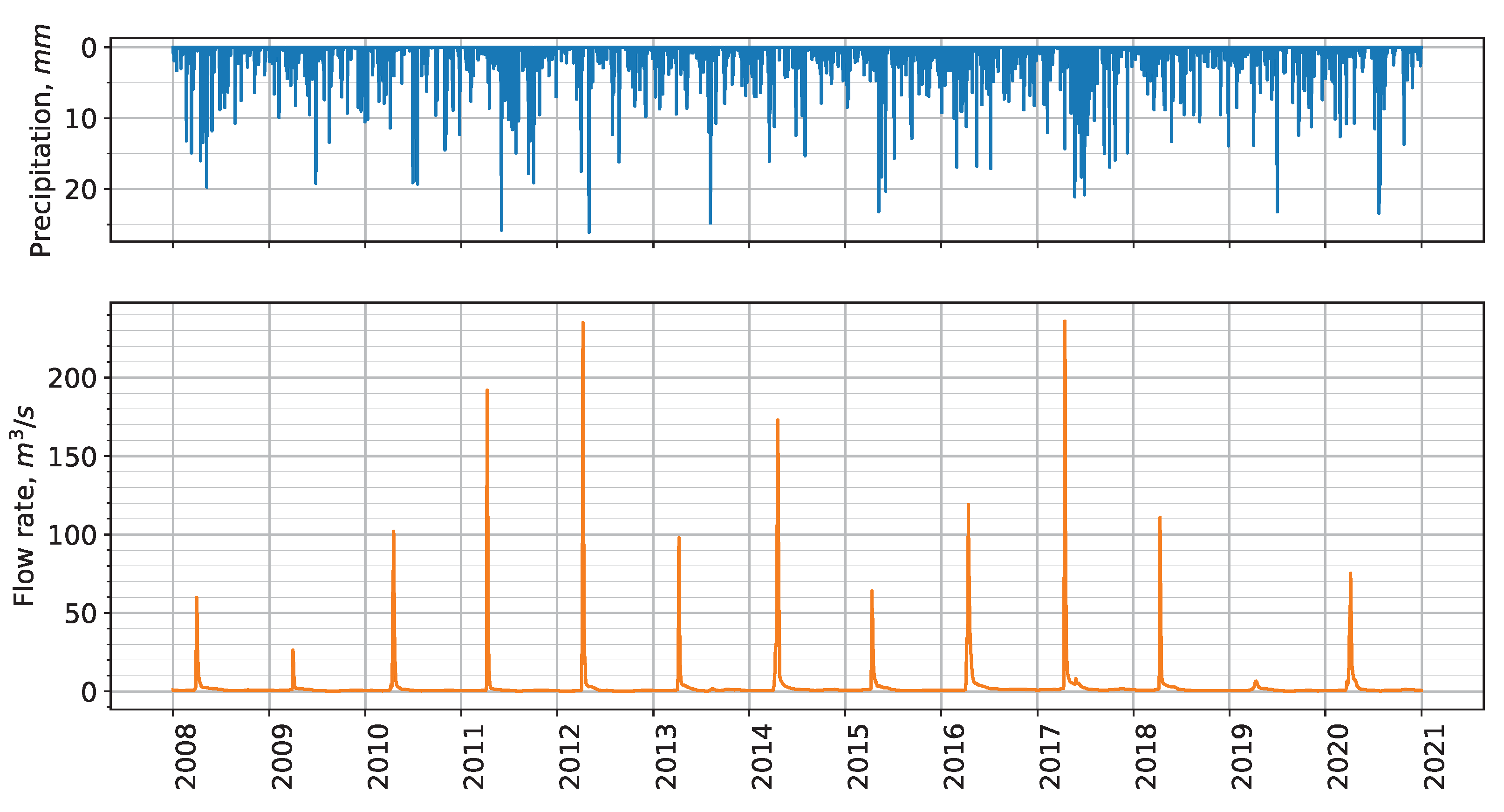
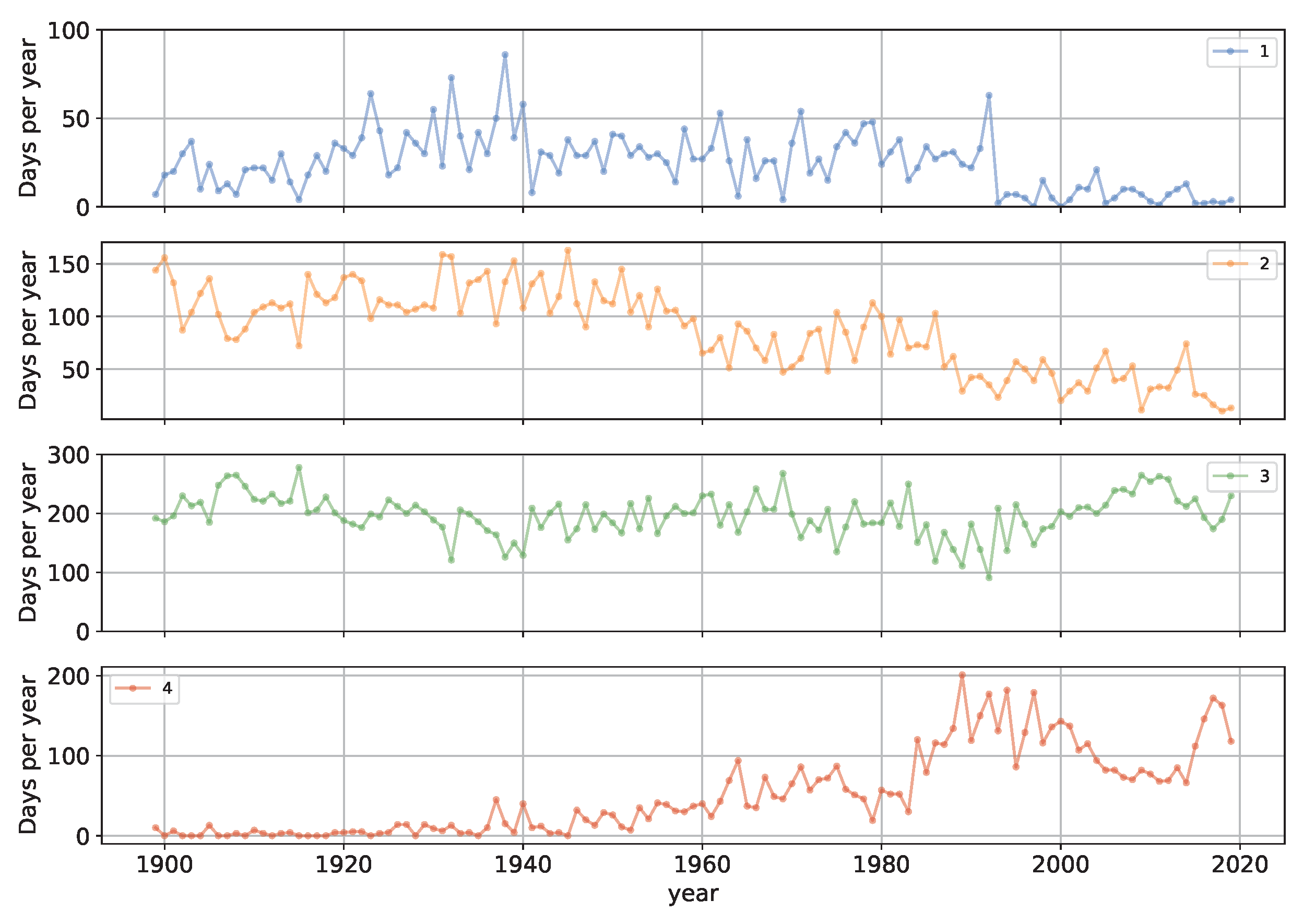
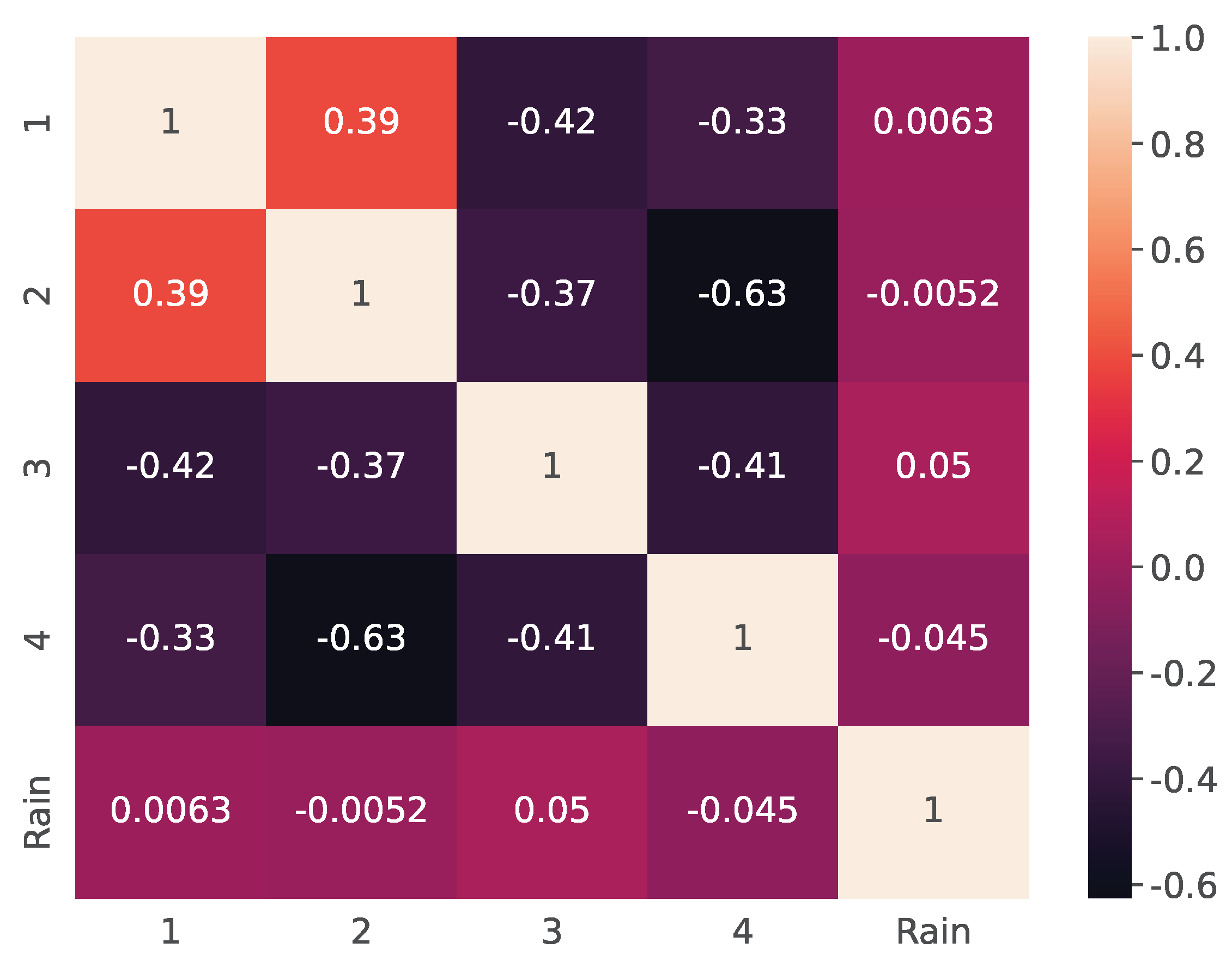
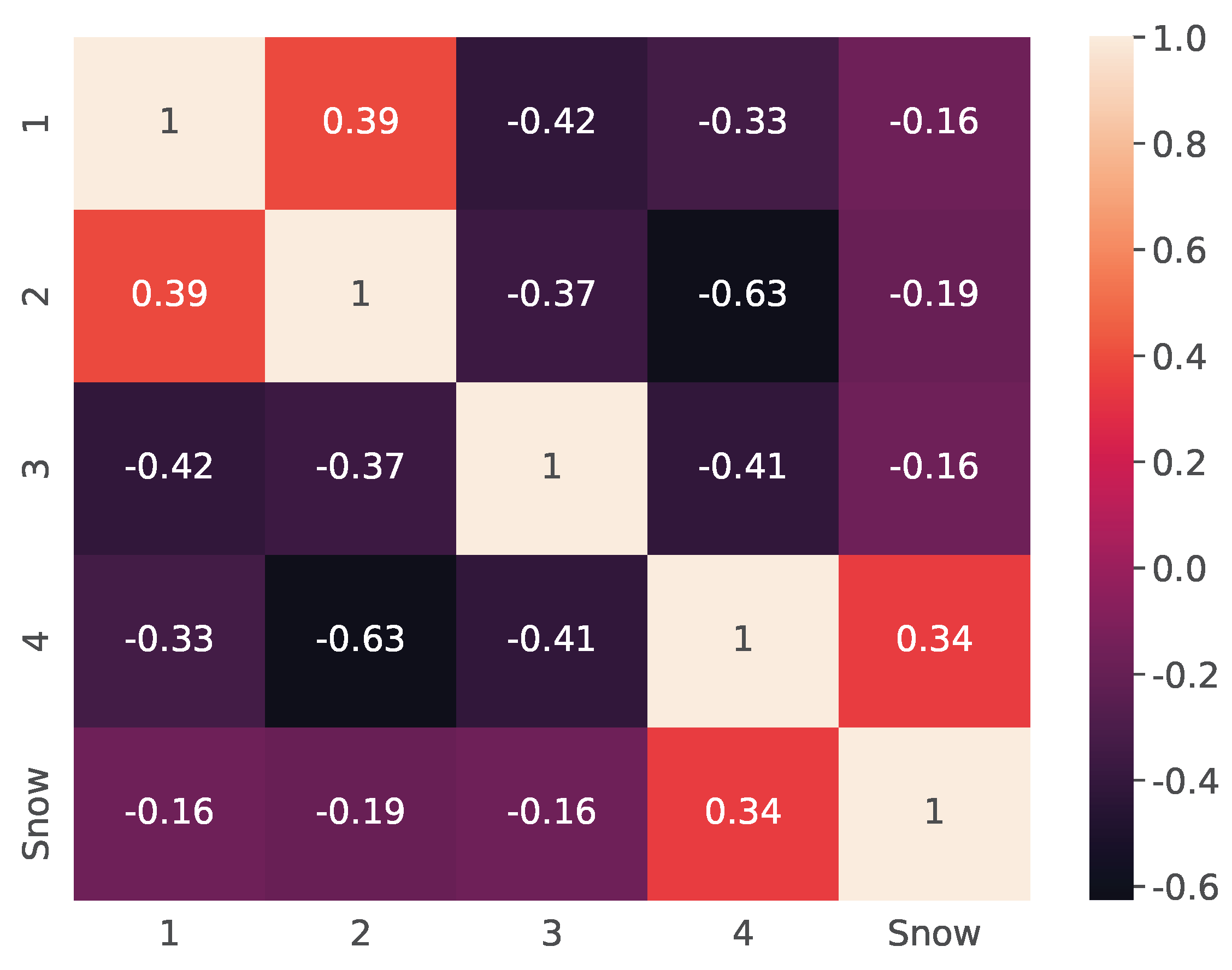







| Modified Calibration Parameter | Parameter Value | Average Relative Error Value, % |
|---|---|---|
| Metric used | NSE | 39 |
| KGE | 41 | |
| 30% NSE 70% KGE | – | |
| 50% NSE 50% KGE | – | |
| 70% NSE 30% KGE | – | |
| Flow rate transformation function | None | 39 |
| Natural logarithm | 34 | |
| Square root | 33 | |
| Squaring | 94 | |
| Coefficient for catchment area | 2 | 35 |
| 1 | 33 | |
| 0.5 | 30 | |
| 0.25 | 25 | |
| 0.1 | 33 | |
| Models used | GR6J | 25 |
| HBV | 28 | |
| 80% GR6J-CN 20% HBV | 24 | |
| 50% GR6J-CN 50% HBV | 25 | |
| 20% GR6J-CN 80% HBV | 27 |
| Parameter | Denotation | Unit | Range of Initial Values | Optimal Values for Catchment under Study |
|---|---|---|---|---|
| Production store capacity | X1 | mm | 36.6–90.02 | 48.22 |
| Intercatchment exchange coefficient | X2 | mm/day | (−1.17)–0.52 | −1.18 |
| Routing store capacity | X3 | mm | 27–150 | 50 |
| Unit hydrograph time constant | X4 | day | 1.37–2.35 | 1.25 |
| Intercatchment exchange threshold | X5 | – | (−0.18)–0.22 | 0.28 |
| Exponential store depletion coefficient | X6 | mm | 20.1–150 | 8.45 |
| Weighting coefficient for snow pack thermal state | X7 | – | 0–0.7 | 0.7 |
| Degree-day melt coefficient | X8 | mm/(∘C · day) | 3.8–6.8 | 4.96 |
| Accumulation threshold | X9 | mm | 15–85 | 50 |
| Percentage (between 0 and 1) of annual snowfall defining the melt threshold | X10 | – | 0.15–0.85 | 0.17 |
| Parameter | Denotation | Unit | Range of Initial Values | Optimal Values for Catchment under Study |
|---|---|---|---|---|
| Threshold temperature for snow and snowmelt | TT | ∘C | (−3)–1 | −0.2 |
| Degree-day factor for snowmelt | CFMAX | mm/(∘C · day) | 0.06–10 | 3.93 |
| Snowfall correction factor | SFCF | – | 0.4–1.6 | 1 |
| Refreezing coefficient for water in the snowpack | CFR | – | 0.001–0.9 | 0.05 |
| Liquid water holding capacity of the snowpack | CWH | – | 0.001–0.9 | 0.2 |
| Maximum percolation from upper to lower groundwater storage | PERC | mm/day | 0–3 | 0.59 |
| Threshold for quick runoff for K0 outflow | UZL | mm | 0–100 | 90 |
| Recession coefficient (quick runoff) | K0 | – | 0.001–0.5 | 0.17 |
| Recession coefficient (upper groundwater storage) | K1 | – | 0.0001–0.2 | 0.15 |
| Recession coefficient (lower groundwater storage) | K2 | – | (2 × 10−6)–0.005 | 0.004 |
| Routing, length of triangular weighting function | MAXBAS | day | 1–7 | 1.58 |
| Maximum amount of soil moisture storage | FC | mm | 50–550 | 124.5 |
| Threshold for reduction in evaporation | LP | – | 0.3–1 | 0.8 |
| Shape coefficient in soil routine | BETA | – | 1–5 | 3.5 |
Disclaimer/Publisher’s Note: The statements, opinions and data contained in all publications are solely those of the individual author(s) and contributor(s) and not of MDPI and/or the editor(s). MDPI and/or the editor(s) disclaim responsibility for any injury to people or property resulting from any ideas, methods, instructions or products referred to in the content. |
© 2024 by the authors. Licensee MDPI, Basel, Switzerland. This article is an open access article distributed under the terms and conditions of the Creative Commons Attribution (CC BY) license (https://creativecommons.org/licenses/by/4.0/).
Share and Cite
Eroshenko, S.; Shmakov, E.; Klimenko, D.; Iumanova, I. Spring Runoff Simulation of Snow-Dominant Catchment in Steppe Regions: A Comparison Study of Lumped Conceptual Models. Inventions 2024, 9, 109. https://doi.org/10.3390/inventions9050109
Eroshenko S, Shmakov E, Klimenko D, Iumanova I. Spring Runoff Simulation of Snow-Dominant Catchment in Steppe Regions: A Comparison Study of Lumped Conceptual Models. Inventions. 2024; 9(5):109. https://doi.org/10.3390/inventions9050109
Chicago/Turabian StyleEroshenko, Stanislav, Evgeniy Shmakov, Dmitry Klimenko, and Irina Iumanova. 2024. "Spring Runoff Simulation of Snow-Dominant Catchment in Steppe Regions: A Comparison Study of Lumped Conceptual Models" Inventions 9, no. 5: 109. https://doi.org/10.3390/inventions9050109
APA StyleEroshenko, S., Shmakov, E., Klimenko, D., & Iumanova, I. (2024). Spring Runoff Simulation of Snow-Dominant Catchment in Steppe Regions: A Comparison Study of Lumped Conceptual Models. Inventions, 9(5), 109. https://doi.org/10.3390/inventions9050109







